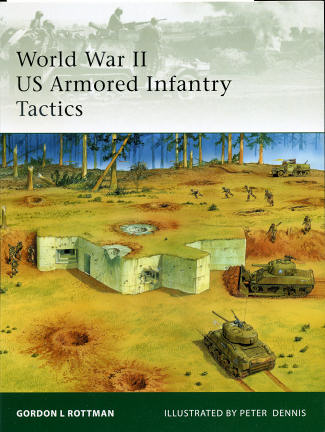 This
edition from Osprey's "Elite"
series covers the use of American armored infantry tactics during World War Two.
When the US decided to utilize tanks as part of the Army back in the very late
1920s and early 1930s, there was considerable discussion on how these weapons
were to be used. One camp wanted them to be mobile infantry support while the
other saw the tank as a replacement for the horse in cavalry units, charging
ahead to break through enemy lines. Of course, the correct use as a bit of both.
However, it took quite a while to figure that out and tanks were placed in with
infantry battalions and were also stand alone cavalry units.
This
edition from Osprey's "Elite"
series covers the use of American armored infantry tactics during World War Two.
When the US decided to utilize tanks as part of the Army back in the very late
1920s and early 1930s, there was considerable discussion on how these weapons
were to be used. One camp wanted them to be mobile infantry support while the
other saw the tank as a replacement for the horse in cavalry units, charging
ahead to break through enemy lines. Of course, the correct use as a bit of both.
However, it took quite a while to figure that out and tanks were placed in with
infantry battalions and were also stand alone cavalry units.
It was eventually decided in about 1943, that having an armored infantry unit
would be the best way to deal with the situation. In this sort of structure,
there would be a combination of motorized infantry, using trucks and halftracks
along with their various towed artillery and tank units, including gun motor
carriages. Working together, they would be able to not only do a fast
breakthrough of enemy lines, but also have the infantry support needed to hold
the break open and to fight in the sort of terrain where just tanks alone would
be at a disadvantage.
Of course, there seems to have never been enough infantry to
satisfy commanders, and most unusually, there was no set doctrine until just a
few months before the war was over. By that time, units had already learned on
the job what was needed. I found it most interesting that when a unit had
trained in the US, the Army pulled the cadre of most well trained soldiers to
help form a new unit, sending the allegedly ready to go unit into combat with a
large number of raw, and often untrained men to fill the ranks. It is a wonder
that things went as well as they did.
Author Gordon L. Rottman covers the organization of these
units, the weapons and equipment they used as well as what tactics, theory and
capabilities were developed as these units were used in combat. Then there was
the understanding and exploitation of the strengths and weaknesses of these
units and how they performed in action. Bolstered by a well done selection of
period photographs and the superb artwork of Peter Dennis, it makes into an
excellent book on the subject. One in which I learned a lot and can easily
recommend to you.
November 2009.
For more on the complete line of Osprey books,
visit www.ospreypublishing.com. In the US, it is
Osprey Direct at 44-02 23rd St, Suite 219, Long Island City, NY 11101., where you can
get a catalogue of available books.
If you would like your product reviewed fairly and quickly, please contact
me or see other details in the Note to
Contributors.
 This
edition from Osprey's "Elite"
series covers the use of American armored infantry tactics during World War Two.
When the US decided to utilize tanks as part of the Army back in the very late
1920s and early 1930s, there was considerable discussion on how these weapons
were to be used. One camp wanted them to be mobile infantry support while the
other saw the tank as a replacement for the horse in cavalry units, charging
ahead to break through enemy lines. Of course, the correct use as a bit of both.
However, it took quite a while to figure that out and tanks were placed in with
infantry battalions and were also stand alone cavalry units.
This
edition from Osprey's "Elite"
series covers the use of American armored infantry tactics during World War Two.
When the US decided to utilize tanks as part of the Army back in the very late
1920s and early 1930s, there was considerable discussion on how these weapons
were to be used. One camp wanted them to be mobile infantry support while the
other saw the tank as a replacement for the horse in cavalry units, charging
ahead to break through enemy lines. Of course, the correct use as a bit of both.
However, it took quite a while to figure that out and tanks were placed in with
infantry battalions and were also stand alone cavalry units.